
- Usage in publication:
-
- Guttenberg limestone
- Modifications:
-
- Original reference
- Dominant lithology:
-
- Limestone
- AAPG geologic province:
-
- Iowa shelf
Summary:
Pg. 16. Guttenberg limestone member of Decorah formation. Middle member of Decorah formation. At type section it consists of 15.5 feet of brownish fine-textured limestone. Northward from this locality this limestone grades into shale. In northwestern Illinois the Guttenberg is the "oil rock" member at base of Galena formation. In southeastern part of outcrop in Iowa the limestones have been irregularly dolomitized. Fossils are of basal Trenton (Rockland) age. Is overlain by Ion member and underlain by Spechts Ferry member. [See also Kay, Jour. Geol., v. 37, no. 7, Oct.-Nov. 1929, p. 639-671, who stated this member corresponds to CTENODONTA bed of Minnesota and is of late Black River age.]
Type section: in bluff of Mississippi River just northwest of town of Guttenberg, Clayton Co., northeastern IA. Named from town of Guttenberg.
[GNC remark (ca. 1936, US geologic names lexicon, USGS Bull. 896, p. 892): This member has been slightly redefined by Kay. See 1935 entry under Spechts Ferry member. His 1935 report included this member in Trenton.]
Source: US geologic names lexicon (USGS Bull. 896, p. 892).
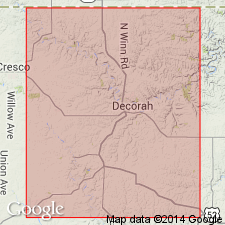
- Usage in publication:
-
- Guttenberg member
- Modifications:
-
- Revised
Summary:
Pg. 295. Guttenberg member of Decorah formation. Showed his Guttenberg member as present in southeastern Minnesota and northwestern Illinois. On p. 286 he showed his Guttenberg member as composing all of his restricted Decorah present near Platteville, Wisconsin. Age is Middle Ordovician.
Source: US geologic names lexicon (USGS Bull. 896, p. 892).
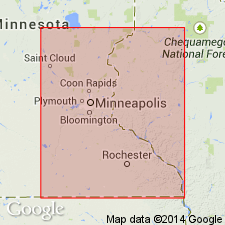
- Usage in publication:
-
- Guttenberg submember
- Modifications:
-
- Revised
- AAPG geologic province:
-
- Iowa shelf
Summary:
Pg. 9 (geol. column), 81, 83, 84, 86. Guttenberg submember of Decorah shale member of Galena formation. Considered submember of Decorah shale member of Galena formation in Minnesota. Lies at base of restricted Decorah shale member and begins with pebbly corrosion zone at top of STICTOPORELLA bed. Largely shale in St. Paul area where it is about 43 feet thick; to south limestone layers increase in importance; chiefly limestone at type locality. Underlies Ion submember. Age is Middle Ordovician.
Source: US geologic names lexicon (USGS Bull. 1200, p. 1636-1637).

- Usage in publication:
-
- Guttenberg formation
- Modifications:
-
- Revised
- AAPG geologic province:
-
- Wisconsin arch
Summary:
Pg. 6, fig. 3. Guttenberg formation of Galena group. Considered formation in Galena group in Dixon-Oregon area, Illinois. Thickness about 5 feet. Includes Garnavillo member below and Glenhaven (Garnet) member above (both new). Underlies Dunleith formation (new); unconformable above Quimbys Mill formation of Platteville group; Spechts Ferry formation absent in this area. Age is Middle Ordovician.
Source: US geologic names lexicon (USGS Bull. 1200, p. 1636-1637).
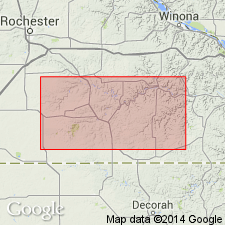
- Usage in publication:
-
- Guttenberg limestone member
- Modifications:
-
- Areal extent
- AAPG geologic province:
-
- Iowa shelf
Summary:
Pg. 763. Guttenberg limestone member of Decorah formation. Members of Decorah formation (Spechts Ferry, Guttenberg, and Ion) not recognizable rock units in Minnesota.
Source: US geologic names lexicon (USGS Bull. 1200, p. 1636-1637).

- Usage in publication:
-
- Guttenberg limestone member*
- Modifications:
-
- Overview
- AAPG geologic province:
-
- Wisconsin arch
- Iowa shelf
Summary:
Pg. 289-293; A.V. Heyl, Jr., and others, 1959, USGS Prof. Paper 309, p. 16. Guttenberg limestone member of Decorah formation. Member commonly 12 to 14 feet thick; less than 2 feet near Rockford, Illinois; about 6.5 feet near Blanchardville, Wisconsin. Limestone, brown, fine-grained, thin-bedded, nodular conchoidal; dark-brown shale; some sections dolomitic; bentonite layer in shale seam near base at Spechts Ferry, Iowa, and northeast of Galena, Illinois, also noted in drillholes in Grant County, Wisconsin. Underlies Ion member and, in some areas, is poorly distinguished or indistinguishable from it; overlies Spechts Ferry member. Where Spechts Ferry member is absent, Guttenberg lies with slight regional disconformity on Quimbys Mill member of Platteville. Age is Middle Ordovician.
Source: US geologic names lexicon (USGS Bull. 1200, p. 1636-1637).
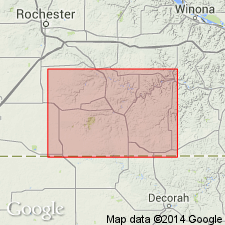
- Usage in publication:
-
- Guttenberg limestone member
- Modifications:
-
- Areal extent
- AAPG geologic province:
-
- Iowa shelf
Summary:
Pg. 1034. Guttenberg limestone member of Decorah formation. In this report [Fillmore County, Minnesota], the unit of green calcareous shale between limestone and Platteville formation and limestone of Galena formation is called Decorah. Therefore Decorah formation of this report includes shaly upper part of Spechts Ferry, the Guttenberg, and, in places, the Ion of Stauffer and Thiel (1941). Age is Middle Ordovician.
Source: US geologic names lexicon (USGS Bull. 1200, p. 1636-1637).
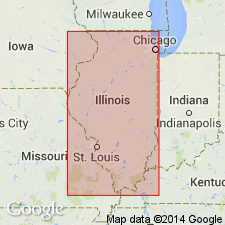
- Usage in publication:
-
- Guttenberg Formation
- Modifications:
-
- Overview
- AAPG geologic province:
-
- Illinois basin
Summary:
Pg. 76-78. Guttenberg Formation of /Decorah subgroup [informal] of Galena Group. Uppermost formation in Decorah subgroup. Widely present in Illinois. In western part of state consists of thin-bedded, tan, white-weathering, very fine-grained limestone interbedded with brown-red shale; locally, in northwestern mining district, represented by brown-red shale called "oil rock." Eastward it grades to brown, white-weathering, medium-grained, vuggy dolomite containing thin beds of brown-red shale. Outcrop thickness about 15 feet in northwestern Illinois, 10 to 15 feet in southwestern Illinois, 3 to 5 feet in central northern Illinois; elsewhere in subsurface is 0 to 3 feet. In central northern area, divided into (ascending) Garnavillo and Glenhaven Members. Overlies Spechts Ferry Formation in northwestern Illinois and Kings Lake Formation in southwestern part of state. Fossiliferous (brachiopods, e.g. SOWERBYELLA, bryozoans, mollusks, trilobites). Includes the RHINIDICTYA and CTENODONTA beds of earlier reports. Equivalent to Napanee Member of Rockland Formation in New York, to upper part of Logana Formation in Kentucky, and to middle part of Hermitage Formation in Tennessee.
["Subgroup" not recognized as a formal stratigraphic rank term (CSN, 1933; ACSN, 1961, 1970; NACSN, 1983, 2005, 2021). Considered informal and should not be capitalized.]
Source: Publication.

- Usage in publication:
-
- Guttenberg Limestone*
- Modifications:
-
- Overview
- AAPG geologic province:
-
- Illinois basin
- Ozark uplift
Summary:
Guttenberg Limestone of Decorah Group. Assigned to Decorah Group in St. Louis area, Illinois and Missouri. Age is Middle Ordovician (Mohawkian). [Author follows usage of Thompson (1991).]
Source: Modified from GNU records (USGS DDS-6; Reston GNULEX).
For more information, please contact Nancy Stamm, Geologic Names Committee Secretary.
Asterisk (*) indicates published by U.S. Geological Survey authors.
"No current usage" (†) implies that a name has been abandoned or has fallen into disuse. Former usage and, if known, replacement name given in parentheses ( ).
Slash (/) indicates name conflicts with nomenclatural guidelines (CSN, 1933; ACSN, 1961, 1970; NACSN, 1983, 2005, 2021). May be explained within brackets ([ ]).

